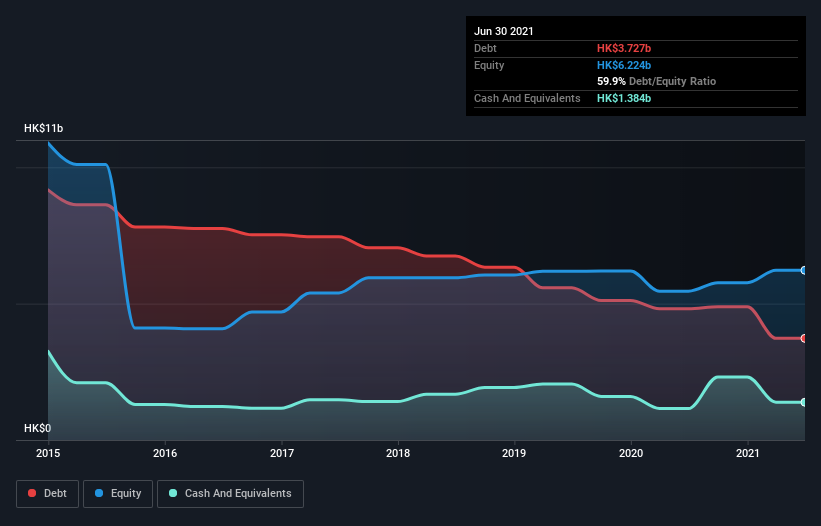- Hong Kong
- /
- Industrials
- /
- SEHK:1205
Here's Why CITIC Resources Holdings (HKG:1205) Has A Meaningful Debt Burden
Warren Buffett famously said, 'Volatility is far from synonymous with risk.' So it might be obvious that you need to consider debt, when you think about how risky any given stock is, because too much debt can sink a company. We note that CITIC Resources Holdings Limited (HKG:1205) does have debt on its balance sheet. But the more important question is: how much risk is that debt creating?
When Is Debt A Problem?
Debt is a tool to help businesses grow, but if a business is incapable of paying off its lenders, then it exists at their mercy. Ultimately, if the company can't fulfill its legal obligations to repay debt, shareholders could walk away with nothing. However, a more frequent (but still costly) occurrence is where a company must issue shares at bargain-basement prices, permanently diluting shareholders, just to shore up its balance sheet. Having said that, the most common situation is where a company manages its debt reasonably well - and to its own advantage. The first thing to do when considering how much debt a business uses is to look at its cash and debt together.
Check out our latest analysis for CITIC Resources Holdings
How Much Debt Does CITIC Resources Holdings Carry?
As you can see below, CITIC Resources Holdings had HK$3.73b of debt at June 2021, down from HK$4.81b a year prior. However, it also had HK$1.38b in cash, and so its net debt is HK$2.34b.

A Look At CITIC Resources Holdings' Liabilities
We can see from the most recent balance sheet that CITIC Resources Holdings had liabilities of HK$1.36b falling due within a year, and liabilities of HK$4.21b due beyond that. Offsetting this, it had HK$1.38b in cash and HK$453.7m in receivables that were due within 12 months. So its liabilities total HK$3.74b more than the combination of its cash and short-term receivables.
This is a mountain of leverage relative to its market capitalization of HK$4.48b. Should its lenders demand that it shore up the balance sheet, shareholders would likely face severe dilution.
We use two main ratios to inform us about debt levels relative to earnings. The first is net debt divided by earnings before interest, tax, depreciation, and amortization (EBITDA), while the second is how many times its earnings before interest and tax (EBIT) covers its interest expense (or its interest cover, for short). This way, we consider both the absolute quantum of the debt, as well as the interest rates paid on it.
CITIC Resources Holdings has a debt to EBITDA ratio of 3.9 and its EBIT covered its interest expense 2.6 times. Taken together this implies that, while we wouldn't want to see debt levels rise, we think it can handle its current leverage. One redeeming factor for CITIC Resources Holdings is that it turned last year's EBIT loss into a gain of HK$232m, over the last twelve months. The balance sheet is clearly the area to focus on when you are analysing debt. But it is CITIC Resources Holdings's earnings that will influence how the balance sheet holds up in the future. So when considering debt, it's definitely worth looking at the earnings trend. Click here for an interactive snapshot.
Finally, while the tax-man may adore accounting profits, lenders only accept cold hard cash. So it's worth checking how much of the earnings before interest and tax (EBIT) is backed by free cash flow. Looking at the most recent year, CITIC Resources Holdings recorded free cash flow of 33% of its EBIT, which is weaker than we'd expect. That weak cash conversion makes it more difficult to handle indebtedness.
Our View
To be frank both CITIC Resources Holdings's net debt to EBITDA and its track record of covering its interest expense with its EBIT make us rather uncomfortable with its debt levels. Having said that, its ability to grow its EBIT isn't such a worry. Looking at the bigger picture, it seems clear to us that CITIC Resources Holdings's use of debt is creating risks for the company. If all goes well, that should boost returns, but on the flip side, the risk of permanent capital loss is elevated by the debt. When analysing debt levels, the balance sheet is the obvious place to start. But ultimately, every company can contain risks that exist outside of the balance sheet. For instance, we've identified 3 warning signs for CITIC Resources Holdings (1 is a bit concerning) you should be aware of.
If you're interested in investing in businesses that can grow profits without the burden of debt, then check out this free list of growing businesses that have net cash on the balance sheet.
New: AI Stock Screener & Alerts
Our new AI Stock Screener scans the market every day to uncover opportunities.
• Dividend Powerhouses (3%+ Yield)
• Undervalued Small Caps with Insider Buying
• High growth Tech and AI Companies
Or build your own from over 50 metrics.
This article by Simply Wall St is general in nature. We provide commentary based on historical data and analyst forecasts only using an unbiased methodology and our articles are not intended to be financial advice. It does not constitute a recommendation to buy or sell any stock, and does not take account of your objectives, or your financial situation. We aim to bring you long-term focused analysis driven by fundamental data. Note that our analysis may not factor in the latest price-sensitive company announcements or qualitative material. Simply Wall St has no position in any stocks mentioned.
Have feedback on this article? Concerned about the content? Get in touch with us directly. Alternatively, email editorial-team (at) simplywallst.com.
About SEHK:1205
CITIC Resources Holdings
An investment holding company, engages in the exploration, development, and production of oil and coal in Mainland China, Australia, Europe, other Asian countries, and internationally.
Excellent balance sheet and fair value.
Market Insights
Community Narratives




